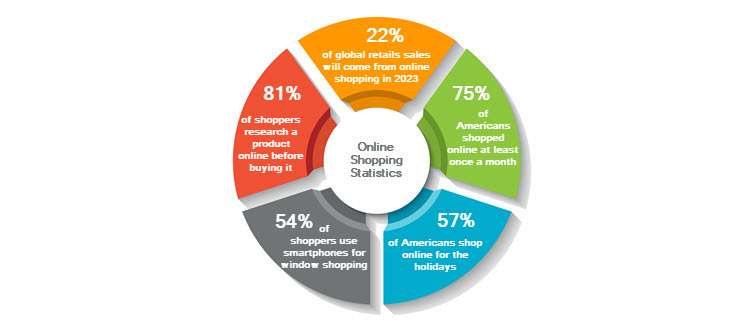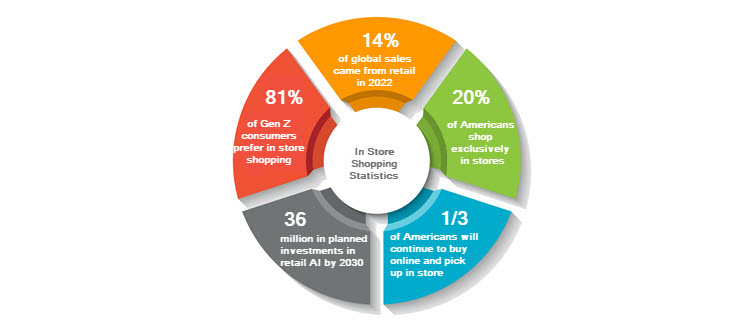Online and in-store shopping are equally appealing to consumers but for different reasons. Online shopping is convenient for customers wanting to make purchases from anywhere and receive deliveries on their doorsteps. Still, a lot of shoppers prefer traditional in-store shopping, where they can see and touch the products before buying them and collect them right away.
In this article, learn about the benefits and drawbacks of both online and in-store shopping, and how they differ.
What Is the Difference Between Online Shopping and In-Store Shopping?

Online shopping happens on merchant websites and shopping apps through the Internet. Customers can scroll through the product offering on their smartphone, tablet, or PC and receive their orders at home instead of going to the store. Also, this sales channel provides merchants an easy way to offer special deals and loyalty programs.
In-store shopping occurs in a brick-and-mortar store, where customers can interact with the product before purchasing it. Shopping in-store allows customers to see how the product works to help them decide if it is right for them. The in-person approach provides good salesmen a chance to upsell or cross-sell.
Obviously, both online shopping and in-store shopping have their distinct benefits and drawbacks.
Online Shopping vs. In-Store Shopping: Benefits
Here is a comparison of online and in-store shopping benefits that lead to increased sales.
Online Shopping Benefits
- Availability. With online shopping, customers can make purchases 24/7/365, regardless of your brick-and-mortar store’s business hours (if you have one).
- Saves time. Online shopping takes place in a few clicks, wherever the customer is, eliminating the need for travel to a physical store.
- Full product offering. Merchants display their entire product offering on websites and shopping apps. On the other hand, physical stores display less products due to limited space or supply issues.
- Side-by-side product comparisons. Customers can compare products and their features thanks to online comparison tools, which is not so easy to do in a physical store.
- Product filtering. Buyers can refine their search based on criteria such as price, color, size, etc.
- Stock information. With online shopping, customers get immediate information about product availability, without having to visit one or more physical stores to find out.
- Inventory management. Online shops ship products directly from a central warehouse which makes inventory management easier.
- Lower overhead costs. Ecommerce merchants avoid many of the expenses related to in-store shopping such as rent, staff salaries, etc.
- Special offers and discount codes. Merchants often give their customers special offers to encourage them to finalize a purchase or make a new one. This includes anything from loyalty discounts for repeat purchases to birthday discount codes and exclusive vouchers redeemable solely online.
- Wider reach. Ecommerce merchants can reach a global audience as they are not limited by geographical location. The wider reach often leads to an increase in sales.
- Testimonials and product reviews. Prospects are more likely to finalize a purchase if they see other people’s experiences online.
- Pressure-free shopping. Some customers prefer to shop slowly at their own pace and without external influence from sales staff.
- Personalized shopping recommendations. Based on the customers’ previous purchases, merchants can recommend products for future purchases or bundles for a great price.
In-Store Shopping Benefits

- Full sensory experience. Customers decide on a purchase easier if they can see how the product looks, works, and fits.
- Instant gratification. When they shop in a brick-and-mortar store, customers get their purchase immediately, without having to wait for it to be delivered.
- Easy returns. Customers can return products directly to the store to get a replacement product or a refund.
- Better customer support. Customers are more likely to finalize a purchase if they can interact with the store staff directly to learn about the products’ best features and functionalities.
- In-store promotions. Physical stores help finalize first-time and impulse purchases through creative use of shop displays and special promotions.
- No shipping costs. Customers do not have the added expense of shipping fees.
Note: Customers can experience the advantages of online shopping and in-store pick up of their items through the Buy Online Pick Up in Store (BOPUS) shopping model.
Online Shopping vs. In-Store Shopping: Drawbacks
Both online and in-store shopping have drawbacks that merchants should keep in mind.
Online Shopping Drawbacks
- Stiff competition. The online retail environment is highly competitive, and merchants must invest considerably in ecommerce marketing to reach their audience and win customers.
- Technological challenges. Ecommerce merchants must constantly invest in the design and functionality of their online stores. Technology changes fast and merchants must keep up with ecommerce trends.
- Ecommerce fraud. Merchants should be on the lookout for ecommerce fraud attempts and telling signs such as unusual orders and transaction volumes, unusual billing and shipping addresses, and discrepant order information. Making sure a company’s assets and customer data remain safe is a continuous effort that merchants must make together with their payment processor.
- Delivery delays. Merchants cannot always guarantee that the products will reach their customers in time since this is affected by many things (shipping companies, weather conditions, public holidays, etc.)
- More frequent returns. Online shopping is more likely to lead to returns and refunds since customers cannot interact with the product to see if it is right for them.
- Added costs for customers. Shipping increases the amount customers must spend to get what they want. These added expenses frequently lead to abandoned carts but the alternative – free shipping – is not always a financially viable solution for merchants.
In-Store Shopping Drawbacks
- Limited product availability. Sales are limited to the products available in the store. If customers cannot find the color, size, model or type of the product they want, they abandon their purchase.
- Limited customer reach. A physical store limits merchants to people who are in the same geographical location. Opening new stores to reach customers in other localities requires careful consideration and a significant financial investment.
- High overhead costs. In-store shopping brings more costs to merchants such as staff salaries, store rent, bills, etc.
- Time-consuming for customers. Shopping in-store takes more time – the customer needs to get to the store, browse through the aisles, find the right employee if they have questions and wait in line to pay. This may lead to customers giving up on the purchase and switching to online shopping.
Online Shopping vs. In-Store Shopping: Statistics
Here are the trends and statistics in online and in-store shopping you should know about.
Online Shopping Statistics

- It is expected that over 22% of global retail sales will come from online shopping in 2023.
- At least 75% of U.S. consumers shopped online at least once a month in 2022.
- 81% of shoppers research the product online before purchasing it.
- 54% of mobile shoppers use their smartphones to window shop.
- 57% of U.S. customers prefer online shopping during the holidays.
In-Store Shopping Statistics

- 14% of global ecommerce sales came from retail in 2022.
- 81% of Gen Z consumers in the U.S. prefer in-store shopping because it is a way to disconnect from the digital world.
- 20% of U.S. consumers shop exclusively in physical stores.
- Retailers plan to invest over $36 million in artificial intelligence in their stores by 2030.
- A third of all U.S. shoppers plan to continue to shop online and collect their items in stores (BOPUS).
Which Is Better: Shopping Online or Purchasing in-Store?
There are certain products that customers prefer to buy online, either because the deals are better or they want the products delivered. These include:
- Books and media. Online libraries and streaming platforms offer unlimited books, movies, and music via subscriptions.
- Electronics and accessories. Customers like buying these items online because it is easier to compare offers and products and read up on customer reviews.
- Gifts. Consumers prefer to avoid the holiday rush in stores. Online gift shopping also makes it easy to send the gift directly to the recipient.
- Art and home décor. Because of their bulkiness, customers prefer to buy these products online and have them delivered. In addition, some ecommerce stores offer AI features that allow customers to check how the products would fit in their homes.
On the other hand, in-store shopping is the preferred option for products consumers need to see, touch, or try on before buying. They include:
- Groceries. Customers prefer to buy perishables and nonperishables after they’ve seen or touched them.
- Beauty products. Customers can test if the colors and textures of beauty products suit them.
- Clothes and shoes. These are the items that customers return most often when buying online because it can be difficult to judge whether the size, color, material, or fit is right.
- Home and garden supplies. Customers prefer to check in person how these items work, usually with the assistance of store staff.
Conclusion
Neither online nor in-store shopping are going anywhere. While online shopping is great for consumers who prefer to shop at their own leisure and receive products at home, in-store shopping brings instant gratification and the human touch.
Merchants do not need to choose one or the other model. They can exploit the benefits of both online and in-store shopping with omnichannel retail to expand their reach, engage their customers, and increase profit.
